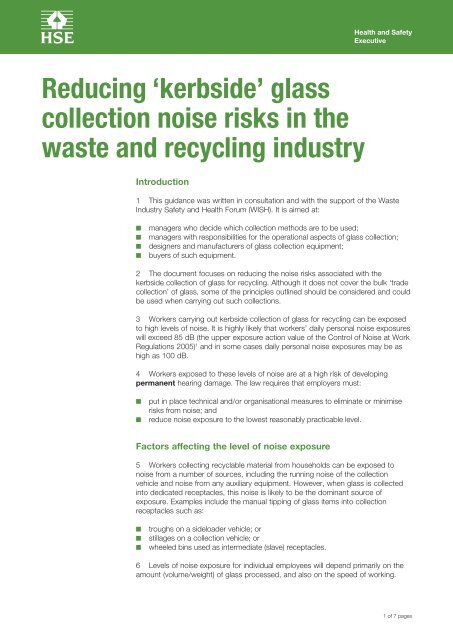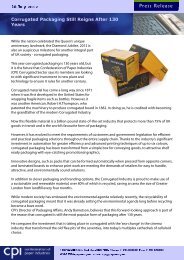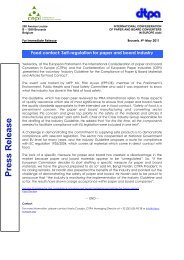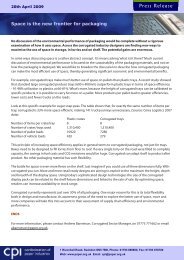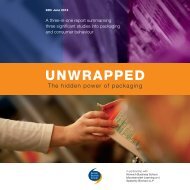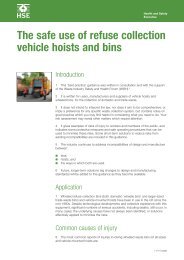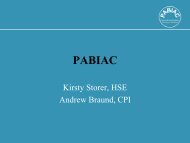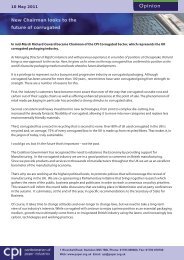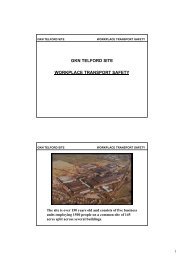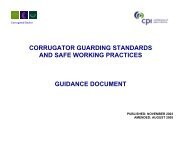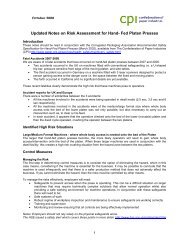Glass Collection Noise Risks In The Waste - HSE
Glass Collection Noise Risks In The Waste - HSE
Glass Collection Noise Risks In The Waste - HSE
You also want an ePaper? Increase the reach of your titles
YUMPU automatically turns print PDFs into web optimized ePapers that Google loves.
Health and Safety<br />
Executive<br />
Reducing ‘kerbside’ glass<br />
collection noise risks in the<br />
waste and recycling industry<br />
<strong>In</strong>troduction<br />
1 This guidance was written in consultation and with the support of the <strong>Waste</strong><br />
<strong>In</strong>dustry Safety and Health Forum (WISH). It is aimed at:<br />
■■<br />
■■<br />
■■<br />
■■<br />
managers who decide which collection methods are to be used;<br />
managers with responsibilities for the operational aspects of glass collection;<br />
designers and manufacturers of glass collection equipment;<br />
buyers of such equipment.<br />
2 <strong>The</strong> document focuses on reducing the noise risks associated with the<br />
kerbside collection of glass for recycling. Although it does not cover the bulk ‘trade<br />
collection’ of glass, some of the principles outlined should be considered and could<br />
be used when carrying out such collections.<br />
3 Workers carrying out kerbside collection of glass for recycling can be exposed<br />
to high levels of noise. It is highly likely that workers’ daily personal noise exposures<br />
will exceed 85 dB (the upper exposure action value of the Control of <strong>Noise</strong> at Work<br />
Regulations 2005) 1 and in some cases daily personal noise exposures may be as<br />
high as 100 dB.<br />
4 Workers exposed to these levels of noise are at a high risk of developing<br />
permanent hearing damage. <strong>The</strong> law requires that employers must:<br />
■■<br />
■■<br />
put in place technical and/or organisational measures to eliminate or minimise<br />
risks from noise; and<br />
reduce noise exposure to the lowest reasonably practicable level.<br />
Factors affecting the level of noise exposure<br />
5 Workers collecting recyclable material from households can be exposed to<br />
noise from a number of sources, including the running noise of the collection<br />
vehicle and noise from any auxiliary equipment. However, when glass is collected<br />
into dedicated receptacles, this noise is likely to be the dominant source of<br />
exposure. Examples include the manual tipping of glass items into collection<br />
receptacles such as:<br />
■■<br />
■■<br />
■■<br />
troughs on a sideloader vehicle; or<br />
stillages on a collection vehicle; or<br />
wheeled bins used as intermediate (slave) receptacles.<br />
6 Levels of noise exposure for individual employees will depend primarily on the<br />
amount (volume/weight) of glass processed, and also on the speed of working.<br />
1 of 7 pages
Health and Safety<br />
Executive<br />
Legal duties: Control of <strong>Noise</strong> at Work Regulations 2005. 1<br />
7 Employers should aim to eliminate or minimise risks from noise exposure<br />
so far as is reasonably practicable. Where any employee’s daily personal noise<br />
exposure exceeds the upper exposure action value (85 dB), employers should use<br />
organisational or technical measures to reduce noise exposure to as low a level as<br />
is reasonably practicable.<br />
8 Where daily personal noise exposures are found to be at or above 87 dB (the<br />
exposure limit value set out in the above Regulations) you must take immediate<br />
action to prevent this level of exposure being exceeded again. Work should not<br />
continue until you can ensure that effective daily personal noise exposures are<br />
below 87 dB, through organisational and technical noise control measures and the<br />
use of personal hearing protection.<br />
9 <strong>The</strong> Regulations place further duties in respect of personal hearing protection,<br />
information, instruction and training for employees, and health surveillance. Further<br />
information on the requirements of the Control of <strong>Noise</strong> at Work Regulations can be<br />
found in the free leaflet <strong>Noise</strong> at work: Guidance for employers 2 and in the priced<br />
publication Controlling noise at work. 3<br />
Risk assessment<br />
10 Employers engaged in kerbside collection of glass for recycling should carry<br />
out a risk assessment for noise, which should include an estimate of daily personal<br />
noise exposure of employees for comparison with the action and limit values set<br />
out in the Control of <strong>Noise</strong> at Work Regulations 2005.<br />
11 Where glass is being collected and manually tipped or sorted into collection<br />
vehicles employees will almost certainly be exposed to noise in excess of the upper<br />
exposure action value.<br />
12 <strong>Noise</strong> levels associated with glass tipping ‘events’ are shown in Table 1, with<br />
corresponding daily personal noise exposures for various numbers of events.<br />
<strong>The</strong> values in the table have been gathered from field studies of kerbside glass<br />
collection activities, and represent the noise level at the ear of the worker. <strong>In</strong> this<br />
context, ‘event’ means the act of emptying a single kerbside container in to the<br />
collection receptacle; it does not include the emptying of the trough into the body<br />
of the vehicle.<br />
13 A range of levels is shown for each type of event since the amount of glass<br />
in each container may vary, and the mix of materials in a container will affect<br />
the working method adopted by the employee (see below). <strong>The</strong> ‘typical’ value is<br />
considered to be representative of the activity.<br />
14 <strong>The</strong> data in Table 1 should be sufficient for you to estimate noise exposure<br />
based on your collection type and number of noise events that each employee<br />
is exposed to per day. You can make your own measurements of noise for the<br />
purposes of confirming noise exposure at your operations especially if they vary<br />
significantly from those described.<br />
Reducing ‘kerbside’ glass collection noise risks in the waste and recycling industry<br />
2 of 7 pages
Health and Safety<br />
Executive<br />
Table 1 Typical noise levels from glass collection activities and personal noise<br />
exposure based on number of events<br />
<strong>Glass</strong> collection type<br />
Typical<br />
single event<br />
noise level<br />
(L AE<br />
), dB<br />
Daily noise exposure L EP,d<br />
, dB<br />
(noise exposure points*)<br />
50 events/<br />
day<br />
100 events/<br />
day<br />
200 events/<br />
day<br />
500 events/<br />
day<br />
Co-mingled glass/<br />
plastic/cans,<br />
sorted at vehicle<br />
<strong>Collection</strong> to<br />
metal troughs on<br />
sideloader vehicle<br />
<strong>Collection</strong> to<br />
metal stillages on<br />
collection vehicle<br />
111<br />
(range:<br />
102–116)<br />
110<br />
(range:<br />
98– 114)<br />
83<br />
(65)<br />
82<br />
(50)<br />
86<br />
(130)<br />
85<br />
(100)<br />
89<br />
(250)<br />
88<br />
(200)<br />
93<br />
(630)<br />
92<br />
(500)<br />
<strong>Collection</strong> to<br />
metal troughs on<br />
sideloader vehicle<br />
117<br />
(range:<br />
111–119)<br />
89<br />
(250)<br />
92<br />
(500)<br />
95<br />
(1000)<br />
99<br />
(2500)<br />
<strong>Glass</strong> only<br />
<strong>Collection</strong> to ‘slave’<br />
wheeled bins (glass<br />
only)<br />
115<br />
(range:<br />
104–120)<br />
87<br />
(160)<br />
90<br />
(320)<br />
93<br />
(630)<br />
97<br />
(1600)<br />
* <strong>Noise</strong> exposure points provide a simple way of expressing personal noise exposure. Exposure points for individual tasks<br />
can be added together. For example, in the table above, noise exposure from 300 events per day can be found by adding the<br />
exposure points for 100 and 200 events. <strong>The</strong> total exposure points for a working day can be converted to daily personal noise<br />
exposures (L EP,d<br />
) as follows: L EP,d<br />
80 dB/32 points; 85 dB/100 points; 87 dB/160 points; 90 dB/320 points; 95 dB/1000 points.<br />
Measures to eliminate or reduce risks<br />
Employer<br />
15 <strong>The</strong> Control of <strong>Noise</strong> at Work Regulations 2005 require the elimination of<br />
noise risks, or reduction of noise risks and noise exposures to as low a level as<br />
reasonably practicable. Employers should consider the following measures and<br />
should implement them as far as is reasonably practicable.<br />
■ ■ Alternative working methods. Employers should consider alternative working<br />
methods and collection strategies which eliminate or reduce the risks from<br />
noise. Remember that changing glass collection systems may have implications<br />
other than on the health and safety of employees.<br />
Methods of collecting glass that do not require the glass to be manually tipped<br />
or sorted at the kerbside will remove a significant source of noise exposure, and<br />
employers should consider these in developing recyclable collection strategies.<br />
Field studies suggest that glass-only collection can result in significantly higher<br />
noise exposures than co-mingled, kerbside-sorted collection using existing<br />
methods. It is likely that changing from glass-only to multi-material collection<br />
would reduce noise exposure for employees. However, kerbside-sorted<br />
collection is itself a significantly noisy activity and further measures to reduce<br />
exposure, such as described below, would probably be required.<br />
■ ■ Choice of work equipment. Where possible, choose equipment that produces<br />
the least amount of noise. Discuss noise with your plant/machinery suppliers,<br />
and take account of the likely noise levels produced under conditions of<br />
intended use.<br />
Reducing ‘kerbside’ glass collection noise risks in the waste and recycling industry<br />
3 of 7 pages
Health and Safety<br />
Executive<br />
■ ■<br />
Suppliers of machinery have a legal duty to design their machinery for lowest<br />
noise emissions, and to provide information on the noise emitted (see below).<br />
Note that some recycling vehicles may be marked with sound power levels as<br />
required by legislation relating to environmental noise emissions. <strong>The</strong>se noise<br />
values are not meaningful in relation to occupational noise exposure arising<br />
from use of the vehicles in roadside glass collection. Suppliers should provide<br />
useful, representative noise information for users, based on a suitable noise test<br />
method, which may be of their own devising.<br />
Modifications to existing work equipment. <strong>The</strong> noise has been shown<br />
to be dominated by glass-glass impacts, so the most effective engineering<br />
modifications to existing work equipment would be those that reduce impact<br />
noise (slowing speed of collisions between glass items) or provide barriers to<br />
airborne sound.<br />
Some employers have reported success in lining collection receptacles with<br />
resilient material, and providing flaps that reduce the speed of glass as it enters<br />
the receptacle. Tests under controlled conditions 4 have shown that modifications<br />
of these types when combined, and used in conjunction with good practice<br />
working methods, can give reductions in overall noise level of 5 to 9 dB,<br />
when compared with standard metal collection receptacles. This represents a<br />
reduction in noise level of approximately 70 to 85%.<br />
Modifications of this type are likely to result in slightly reduced capacities of<br />
collection receptacle, both because the volume of the receptacle will be reduced<br />
and because of the reduced amount of breakages.<br />
Employers adopting these type of engineering control measures should ensure<br />
that such modifications are used and maintained (eg replace linings if they wear<br />
out, and make sure employees make use of any measures put in place).<br />
■ ■ Work rotation. Reducing the number of glass collection operations carried<br />
out by an employee can also lower their exposure to noise. This method is not<br />
likely to produce significant benefits on its own, but may be a useful additional<br />
option. Reducing the number of operations carried out by 30% would lower<br />
noise exposure by approximately 2 dB. A 50% reduction would lower exposure<br />
by 3 dB.<br />
■ ■ Working methods. <strong>The</strong> working method adopted by employees can affect<br />
noise exposure.<br />
Depositing of glass to the collection receptacle can be done in a rapid/forceful<br />
(‘fast’) or more controlled (‘slow’) manner. ‘Fast’ depositing produces generally<br />
higher noise levels than ‘slow’ depositing, becoming increasingly higher for<br />
individual deposits as the collection receptacle becomes fuller. Tests under<br />
controlled conditions have shown that the benefits of resilient linings and flaps<br />
on collection receptacles are not fully realised where a ‘fast’ depositing method<br />
is used.<br />
Employers should instruct employees to avoid ‘fast’ depositing methods and<br />
ensure, through supervision, that recommended working methods for reduced<br />
noise exposure are used.<br />
Supplier<br />
16 Suppliers of machinery for use at work have duties, under the Supply of<br />
Machinery (Safety) Regulations 1992, as amended, 5 to design and construct<br />
machinery so that noise emissions are reduced to the lowest level, taking account<br />
of technical progress and the availability of means to reduce noise at source. <strong>The</strong><br />
supplier should anticipate the intended use of the machinery, and provide features<br />
in the design that aim to minimise the noise generated during use.<br />
17 Where it is known that recycling collection vehicles and equipment will be<br />
used to collect glass and other materials that are liable to generate noise in their<br />
collection, then this should be taken account of in the design. For example, the<br />
engineering modifications to existing machinery described above (resilient linings<br />
to collection receptacles etc) will be equally applicable to the design of new<br />
Reducing ‘kerbside’ glass collection noise risks in the waste and recycling industry<br />
4 of 7 pages
Health and Safety<br />
Executive<br />
Flap (resilient material<br />
or with resilient lining)<br />
slows speed of<br />
glass into receptacle<br />
prevents some<br />
breakout of noise<br />
Metal trough<br />
or stillage<br />
Radiated noise<br />
Falling glass<br />
Resilient lining<br />
(eg 10 mm<br />
rubber sheet)<br />
slows speed of<br />
glass into receptacle<br />
reduces impact noise<br />
between glass and<br />
receptacle<br />
Figure 1 Design of collection receptacles for reduced noise<br />
machinery. <strong>In</strong>formation should be provided on the noise emitted by the machinery<br />
or equipment under condition of typical use in order to inform potential purchasers<br />
of risks, and allow decisions to be made on the suitability of equipment.<br />
18 Buyers of machinery (including vehicles) for kerbside glass collection should<br />
expect suppliers to have incorporated design features which reduce the noise<br />
generated by glass bottles, jars etc being deposited into collection compartments.<br />
19 Ask potential suppliers about the design features that have been incorporated,<br />
and whether they have information about anticipated noise levels during the activity.<br />
If they have discharged their legal duties, they will have such information to hand.<br />
<strong>The</strong>ir answers may influence your confidence as to whether you will be able to<br />
carry out your work activities while fulfilling your legal duties to ensure the health of<br />
employees.<br />
Personal hearing protection<br />
20 Where employees’ daily personal noise exposure exceeds 85 dB, they must be<br />
supplied with personal hearing protection, which must be worn fully and properly.<br />
Reducing ‘kerbside’ glass collection noise risks in the waste and recycling industry<br />
5 of 7 pages
Health and Safety<br />
Executive<br />
21 <strong>The</strong> law does not allow hearing protection to be used as an alternative to<br />
controlling noise exposure by other means (as described above). It should be used<br />
to protect employees’ hearing while noise control measures are being developed,<br />
and it may be still be necessary to rely on hearing protection after noise exposures<br />
have been reduced to as low as reasonably practicable through other means.<br />
22 <strong>The</strong> working environment during kerbside collection presents a number of risks<br />
to safety, including working around moving vehicles and working on the public<br />
highway. <strong>The</strong> use of personal hearing protection has the potential to increase these<br />
risks by masking important sounds, and by inducing a sense of isolation from the<br />
general working environment. It is therefore necessary to consider these issues,<br />
both when selecting personal hearing protection and devising systems of work.<br />
Consider the following issues:<br />
■■<br />
■■<br />
■■<br />
■■<br />
■■<br />
■■<br />
■■<br />
Choose hearing protection that reduces daily personal noise exposures to at<br />
least below 85 dB, and ideally below 80 dB – the level of protection required<br />
depends on the actual noise exposure.<br />
Provide systems of work to ensure that hearing protection is only worn during<br />
noisy activities and is not worn when it is not needed.<br />
Assess the risk of introducing broken glass into the ear, and minimise it by<br />
selecting an appropriate type of protector and through systems of work,<br />
instructions and training.<br />
Where it is not possible to avoid crossing designated roads, you can minimise<br />
additional risks from the use of personal hearing protection by considering and<br />
implementing, as appropriate, the following options:<br />
- introduce a system of work that includes a requirement to remove hearing<br />
protection prior to attempting to cross a road;<br />
- in conjunction with the system of work above, provide hearing protectors<br />
that are simple to remove and replace as required, for example canal caps or<br />
earmuffs;<br />
- provide ‘level-dependent’ (sometimes called ‘amplitude-sensitive’) hearing<br />
protectors which are designed to protect against hazardous noise while<br />
permitting quieter sounds to be relayed to the wearer in the absence of high<br />
noise levels;<br />
- provide ‘flat frequency response’ hearing protectors which can, in some<br />
situations, improve the ability of wearers to hear certain sounds such as<br />
speech communication, warning signals and other informative sounds.<br />
<strong>In</strong> all cases, employees using personal hearing protection must be given<br />
information, instruction and training that should cover how to obtain personal<br />
hearing protection from the employer, its correct use and requirements for<br />
maintenance.<br />
Employees should also receive training in any systems of work designed to<br />
facilitate the full and proper use of hearing protection in the particular working<br />
environment. This training should be in addition to any other training provided<br />
with regard to noise, as described above.<br />
Employers should provide appropriate supervision to ensure that hearing<br />
protection is being worn, and that systems of work are being followed.<br />
Health surveillance<br />
23 All employees whose daily personal noise exposure frequently exceeds 85 dB,<br />
or whose hearing is at risk, should be provided with health surveillance for hearing<br />
damage. This should include a baseline hearing check on first entering a noisy<br />
job, annual checks for two years, and then regular checks at three-yearly intervals.<br />
Further advice on health surveillance can be found in the <strong>HSE</strong> publication <strong>Noise</strong> at<br />
work: Guidance for employers on the Control of <strong>Noise</strong> at Work Regulations 2005. 2<br />
Reducing ‘kerbside’ glass collection noise risks in the waste and recycling industry<br />
6 of 7 pages
Health and Safety<br />
Executive<br />
References<br />
1 Control of <strong>Noise</strong> at Work Regulations 2005 SI 2005/1643 <strong>The</strong> Stationery Office<br />
2 <strong>Noise</strong> at work: Guidance for employers on the Control of <strong>Noise</strong> at Work<br />
Regulations 2005 Leaflet INDG362(rev1) <strong>HSE</strong> Books 2005 (single copy free or<br />
priced packs of 10 ISBN 978 0 7176 6165 7) www.hse.gov.uk/pubns/indg362.pdf<br />
3 Controlling noise at work. <strong>The</strong> Control of <strong>Noise</strong> at Work Regulations 2005.<br />
Guidance on Regulations L108 (Second edition) <strong>HSE</strong> Books 2005<br />
ISBN 978 0 7176 6164 0<br />
4 <strong>Glass</strong> recycling: <strong>Noise</strong> exposure from simulated roadside collection: Follow-up<br />
measurements RR651 <strong>HSE</strong> Books 2008 www.hse.gov.uk/research<br />
5 Supply of Machinery (Safety) Regulations 1992 SI 1992/3073, as amended by<br />
SIs 1994/2063 and 2004/693 <strong>The</strong> Stationery Office 1992<br />
<strong>The</strong> Stationery Office publications are available from <strong>The</strong> Stationery Office,<br />
PO Box 29, Norwich NR3 1GN Tel: 0870 600 5522 Fax: 0870 600 5533 e-mail:<br />
customer.services@tso.co.uk Website: www.tso.co.uk (<strong>The</strong>y are also available from<br />
bookshops.) Statutory <strong>In</strong>struments can be viewed free of charge at www.opsi.gov.uk.<br />
Further reading<br />
<strong>HSE</strong>’s noise at work website: www.hse.gov.uk/noise/index.htm<br />
‘<strong>Glass</strong> recycling: noise exposure from simulated roadside collection of recyclable<br />
glass’ Health and Safety Laboratory HSL/2007/21 www.hse.gov.uk/research/<br />
hsl_pdf/2007/hsl0721.pdf<br />
<strong>The</strong> <strong>Waste</strong> <strong>In</strong>dustry Safety and Health forum (WISH) exists to communicate and<br />
consult with key stakeholders, including local and national government bodies,<br />
equipment manufacturers, trade associations, professional associations and trade<br />
unions. <strong>The</strong> aim of WISH is to identify, devise and promote activities that can<br />
improve industry health and safety performance.<br />
Further information<br />
<strong>HSE</strong> priced and free publications are available by mail order from <strong>HSE</strong> Books, PO<br />
Box 1999, Sudbury, Suffolk CO10 2WA Tel: 01787 881165 Fax: 01787 313995<br />
Website: www.hsebooks.co.uk (<strong>HSE</strong> priced publications are also available from<br />
bookshops and free leaflets can be downloaded from <strong>HSE</strong>’s website: www.hse.<br />
gov.uk.)<br />
For information about health and safety ring <strong>HSE</strong>’s <strong>In</strong>foline Tel: 0845 345 0055 Fax:<br />
0845 408 9566 Textphone: 0845 408 9577 e-mail: hse.infoline@natbrit.com or<br />
write to <strong>HSE</strong> <strong>In</strong>formation Services, Caerphilly Business Park, Caerphilly CF83 3GG.<br />
This document contains notes on good practice which are not compulsory<br />
but which you may find helpful in considering what you need to do.<br />
This document can be found at: www.hse.gov.uk/pubns/waste16.pdf.<br />
© Crown copyright This publication may be freely reproduced, except for<br />
advertising, endorsement or commercial purposes. First published 11/08. Please<br />
acknowledge the source as <strong>HSE</strong>.<br />
Published by the Health and Safety Executive <strong>Waste</strong>16 11/08<br />
7 of 7 pages


